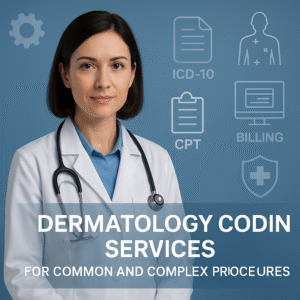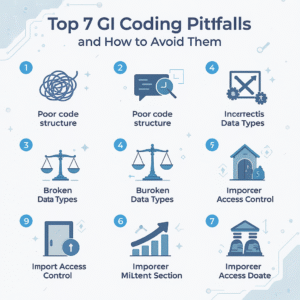Affordable Medical Coding Services Without Sacrificing Quality: The Ultimate Guide for Healthcare Facilities
Medical Coding Services
Medical Coding Services
In the complex Spanish healthcare ecosystem, where financial sustainability and clinical excellence must coexist harmoniously, medical coding emerges as one of the fundamental pillars that determine the success or failure of any medical practice. The reality is overwhelming: affordable medical coding services are not only possible without sacrificing quality, but they represent a strategic investment that can radically transform the financial health of your healthcare facility .

Medical coding goes beyond simply assigning codes. It’s the critical link that connects exceptional clinical care to the economic viability of your practice. Accurate and efficient coding ensures that every service rendered, every procedure performed, and every diagnosis established is correctly translated into claims that insurers will process and pay without delays or denials.
Errors in this process aren’t mere administrative inconveniences; they represent financial drains that can compromise your center’s sustainability. Claim denials, payment delays, regulatory audits, and lost revenue due to undercoding are all direct consequences of poor coding, which, paradoxically, often arises from misguided attempts to “cut corners” on this critical service.
The Current Paradigm: Understanding the Medical Coding Ecosystem in Spain
The Complexity of the Spanish Healthcare System
The Spanish healthcare system presents unique characteristics that make medical coding a particularly complex challenge. The coexistence of the public health system (NHS) with private insurance, mutual insurance companies, and specialized insurers creates a network of coding and billing requirements that vary significantly depending on the type of payer.
In this context, private clinics face particular pressures. They must navigate between different coding systems (ICD-10-ES, ICD-9-CM for procedures in some cases), adapt to the specific requirements of each insurer, and maintain compliance with increasingly stringent regulations regarding data protection and transparency in healthcare billing.
The Economic Dilemma: Beyond Cost vs. Quality
The financial management of a modern medical practice goes far beyond the simple cost-benefit equation. In the field of medical coding, this complexity increases exponentially.
The Hidden Costs of Poor Coding:
Cascading Denials: A single miscoded claim not only represents the loss of that specific income, but can trigger a systematic review by the insurer of all similar claims. This can result in the retroactive denial of multiple claims and the demand for repayment of payments already received.
The Systemic Undercoding Phenomenon: Many practices lose between 10% and 20% of their potential revenue due to undercoding. This includes not only the omission of secondary procedures or additional diagnoses, but also coding at lower levels of complexity than justified by clinical documentation.
Cash Flow Impact: Payment delays due to incorrect claims can create liquidity crises, especially in small clinics where every euro counts. A 60-day delay in claim payment can require resorting to external financing, generating additional financial costs.
Opportunity Costs: The time your administrative team spends correcting coding errors is time they can’t invest in value-generating activities, such as improving the patient experience or developing new services.
Deterioration of Payer Relationships: Insurers maintain provider risk profiles. A practice with high coding error rates may see claims processing times increase, face more frequent audits, or even be excluded from preferred provider networks.
Advanced Strategies for Identifying High-Quality and Affordable Medical Coding Services
1. Deep Needs Analysis: Beyond the Basics
The first step in finding the perfect balance between cost and quality is to conduct a thorough assessment of your current situation. This analysis should go far beyond the basic parameters:
Current Performance Audit:
- Analyze your denial rates by type of service, insurer, and time period
- Identify patterns in the most common coding errors
- Calculate the average time between the provision of the service and the actual payment
- Evaluate the percentage of claims that require manual follow-up
Assessing the Complexity of Your Specialty: Each medical specialty has its own unique coding requirements. Interventional cardiology, for example, requires very specific knowledge of cardiovascular procedure codes and the correlation between diagnoses and procedures. Psychiatry, on the other hand, faces unique challenges in coding mental health services and managing different therapeutic modalities.

Seasonal Workload Analysis: Many specialties experience significant seasonal fluctuations. Allergy clinics see peaks in the spring, while sports medicine clinics may be busier during specific sports seasons. A quality coding provider must be able to adapt to these variations without compromising accuracy or disproportionately increasing costs.
2. Decoding Pricing Models: A Strategic Perspective
A thorough understanding of pricing models goes beyond simply comparing rates. Each model has strategic implications that can significantly impact your practice’s long-term profitability.
Percentage of Collections Model: Advanced Analysis
This model, although popular, requires careful evaluation. A 6% percentage on a €500,000 annual collection represents €30,000, which might seem significant. However, if that provider manages to increase your collection rate from 85% to 95% and reduce your denial rates from 15% to 3%, the value generated can be exponential.
Key Considerations:
- Is the percentage applied to gross or net collections?
- How are adjustments for contractual discounts handled?
- Is there a differential percentage for highly complex claims?
- What happens to claims that require multiple appeals?
Transaction Fees: Optimizing for Variable Volumes
For clinics with highly variable volumes, a hybrid model may be optimal. For example, a base fee per claim for normal volumes, with progressive discounts for high volumes, and a slightly higher fee for very low volumes that require more personalized attention.
Shared Value Models: The Frontier of Innovation
Some advanced providers are implementing models where their revenue is directly tied to specific improvements in KPIs such as a reduction in accounts receivable days (AR days) or an increase in the net collection rate. These models perfectly align the provider’s interests with yours.
3. Certification and Competence: Establishing Standards of Excellence
Quality in medical coding is non-negotiable, but not all certifications are equal.
Certification Hierarchy:
Basic Level – CPC (Certified Professional Coder): Appropriate for general outpatient coding, but may be insufficient for complex specialties.
Intermediate Level – CCS (Certified Coding Specialist): More robust, especially for environments that handle both outpatient and inpatient coding.
Advanced Level – Specialty Certifications: Such as CPC-A (Apprentice), COC (Certified Outpatient Coder), or specialty-specific certifications (CPC-H for cardiology, CPC-O for orthopedics, etc.).

Continuing Education and Specialization:
A quality provider not only employs certified coders, but also continually invests in their development. Specifically, ask:
- How often do you receive training on code updates?
- Do you have coders specialized in your specific medical area?
- Do you participate in conferences and seminars of professional organizations?
- Do you maintain relevant continuing medical education (CME) certifications?
4. Technology and Automation: The Future of Medical Coding
The technological revolution has radically transformed the medical coding landscape, and understanding these technologies is crucial to evaluating providers.
Artificial Intelligence and Natural Language Processing (NLP):
Advanced NLP systems can analyze clinical notes and suggest appropriate codes with accuracy exceeding 95% in many specialties. However, the key lies in implementation: Is the provider using these tools to support expert coders or as a replacement?
Advanced Computer-Assisted Coding (CAC):
The best CAC systems not only suggest codes, but also:
- Identify potential compliance issues before shipping
- Detect opportunities for additional coding (secondary diagnoses, appropriate modifiers)
- They cross-check with specific payer guidelines
- Generate alerts about regulatory changes that affect specific codes
Integration and Interoperability:
A leading-edge provider must be able to integrate seamlessly with:
- Electronic health record systems (Epic, Cerner, Allscripts, etc.)
- Practice management software specific to your specialty
- Billing and accounts receivable systems
- Insurance portals for real-time eligibility and claim status verification
5. Performance Metrics and Predictive Analytics
The best providers go beyond simply processing claims; they become strategic partners that provide valuable insights for revenue cycle optimization.
Advanced KPIs to Require:
First-Pass Yield Rate: The percentage of claims that are processed correctly without the need for review or correction. A world-class provider should exceed 98%.
Average Denial Resolution Time: It’s not just the appeal success rate that matters, but also the speed. An efficient appeals process should resolve 80% of appealable denials in less than 30 days.
Payer Trend Analysis: Can the provider identify changes in denial patterns from specific insurers and proactively adjust coding strategies?
Benchmarking by Specialty: Do they provide comparisons of your performance against industry standards for your specific specialty?
6. Data Security and Regulatory Compliance: Beyond the Basics
In the post-GDPR era, data security isn’t optional; it’s an existential imperative.
Multi-Level Security Framework:
End-to-End Encryption: All data must be encrypted both in transit and at rest, using AES-256 or higher standards.
Multi-Factor Authentication (MFA): Mandatory for all users with access to patient data.
Continuous Security Audits: Question about the frequency of penetration audits, vulnerability assessments, and security certifications (ISO 27001, SOC 2 Type II).
Granular Access Management: Can you restrict access to specific data based on roles and needs?
Incident Response Plan: Do you have a documented and tested plan for responding to security breaches? Does it include notification to regulatory authorities within the 72 hours required by the GDPR?
Maximizing ROI: Advanced Negotiation and Contract Management Strategies
Results-Oriented Contract Structuring
A well-structured contract can be the difference between a successful partnership and a frustrating experience.
Guaranteed Performance Clauses:
Includes penalties for performance below agreed standards:
- If the denial rate exceeds X%, proportional reduction in fees
- Guaranteed response times (TAT) with compensation for delays
- Minimum net collection rate levels

Contractual Scalability:
- Automatic volume discounts that are triggered when you exceed certain thresholds
- Flexibility to adjust the scope of services without penalties
- Options for additional services (compliance audits, profitability analysis per service) at preferential rates
Transparency Metrics:
Demand access to real-time dashboards with:
- Status of all pending claims
- Accounts receivable aging analysis
- Denial trends by insurer and type of service
- Cash flow projections based on outstanding claims
Change Management: Implementation Without Disruptions
The transition to a new coding provider can be traumatic if not managed properly.
Phased Implementation Plan:
Phase 1 – Analysis and Preparation (Weeks 1-2):
- Complete audit of current processes
- Identification of immediate opportunities for improvement
- Setting up technology integrations
- Training of internal team on new procedures
Phase 2 – Controlled Pilot (Weeks 3-6):
- Implementation with a subset of services or providers
- Intensive monitoring of KPIs
- Adjustments based on feedback
Phase 3 – Full Implementation (Weeks 7-8):
- Complete rollout with all services
- Establishing regular review routines
- Continuous data-driven optimization
Risk Management During Transition:
- Backup maintenance of critical processes during the first 8 weeks
- Proactive communication with payers about changes in billing processes
- Daily cash flow monitoring during the transition period
The Future of Medical Coding: Trends and Opportunities
Artificial Intelligence and Machine Learning
AI is revolutionizing medical coding in ways that go beyond simple automation:
Predictive Coding: Algorithms that can suggest codes before clinical documentation is completed, based on diagnostic and treatment patterns.
Anomaly Detection: Systems that identify unusual patterns in coding that could indicate errors or optimization opportunities.
Sentiment Analysis in Documentation: AI that can interpret the context and severity of medical conditions from narrative notes.
Real-Time Coding
The future points towards systems that can automatically code during the clinical encounter:
- Integration with medical voice recognition systems
- Automatic coding based on physician orders and laboratory results
- Real-time validation against payer criteria
Blockchain and Integrity Verification
Blockchain technology can revolutionize data integrity verification and create immutable records of all billing transactions.
Success Stories: Real Transformations in Spanish Practices
Case 1: Cardiology Clinic in Madrid
Initial Situation:
- 450 patients/month
- Denial rate: 18%
- Average collection time: 75 days
- Internal coding cost: €48,000/year (1.5 FTE)
Solution Implementation:
- Specialized cardiology provider
- 5.5% model on collections
- Implementation of AI for coding interventional procedures
Results (12 months later):
- Denial rate reduced to 4%
- Average collection time: 28 days
- Increase in net income: 22%
- Total cost (including supplier): €52,000/year
- ROI: 380%
Case 2: Network of Dermatological Clinics
Initial Situation:
- 8 locations, 1,200 patients/month total
- Inconsistency in coding between locations
- Estimated loss due to undercoding: €85,000/year
Solution Implementation:
- Standardization of processes across all locations
- Specific training in dermatological coding
- Centralized dashboard for monitoring
Results:
- 99% uniformity in coding between locations
- Full recovery of lost revenue due to undercoding
- 40% reduction in administrative time spent on claims follow-up

Supplier Selection: Decision Framework
Weighted Evaluation Matrix
Use this matrix to objectively evaluate potential suppliers:
Evaluation Criteria (Suggested Weighting):
- Experience and Certifications (25%)
- Years of experience in your specialty
- Percentage of certified coders
- Continuing education programs
- Technology and Innovation (20%)
- Level of automation
- Integration capabilities
- Technological development roadmap
- KPIs and Performance (25%)
- Historical accuracy rates
- Response times
- Verifiable references
- Cost Structure (15%)
- Transparency in prices
- Alignment with your financial goals
- Absence of hidden costs
- Security and Compliance (10%)
- Safety certifications
- Experience with Spanish/European regulations
- Incident response protocols
- Support and Communication (5%)
- Support availability
- Quality of communication
- Proactivity in problem solving
Critical Questions for Evaluation
During the selection process, be sure to get specific, verifiable answers to these questions:
About Performance:
- “Can you provide us with specific data on client KPIs similar to ours?”
- “What is your specific process for handling complex denials?”
- “How do you measure and ensure continuous improvement in coding accuracy?”
About Technology:
- “Can you demonstrate your technology platform in operation?”
- “What is your development roadmap for the next 24 months?”
- “How would you adapt to unexpected regulatory or technological changes?”
About Financial Structure:
- “Can you provide a projected ROI analysis specific to our practice?”
- “What are all the associated costs, including implementation and possible extras?”
- “Do you offer performance guarantees with compensation for non-performance?”
Conclusion: Towards a New Era of Strategic Medical Coding
Medical coding has evolved from a purely administrative function to a strategic driver of financial and operational success for medical practices. In this new paradigm, the search for “affordable” coding services must be redefined as the pursuit of maximum value, where quality, technological innovation, and strategic alignment are determining factors.
Healthcare facilities that take a strategic, data-driven approach to selecting their coding partners will not only achieve immediate operational efficiencies but will also position themselves to capitalize on the opportunities presented by a constantly evolving healthcare system.

Investing in high-quality medical coding services isn’t an expense; it’s a strategic investment in the sustainability and growth of your medical practice. In a market where every dollar counts and every mistake can have significant consequences, choosing the right coding partner can be the decision that defines the future of your healthcare facility.
The perfect balance between affordability and quality is not only possible; it’s imperative for success in the modern healthcare ecosystem. The question isn’t whether you can afford to invest in quality medical coding, but whether you can afford not to.



